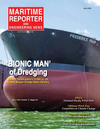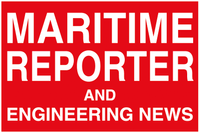
Page 25: of Maritime Reporter Magazine (April 2025)
Read this page in Pdf, Flash or Html5 edition of April 2025 Maritime Reporter Magazine
Regulation Watch de? nes a “cyber incident” and establishes reporting require- controls compliance will also take effect. Two years ago, con- ments for them. This reporting requirement also applies to tainer and refrigerated cargo vessels, as well as passenger foreign-? agged vessels operating in U.S. waters and ports. cruise vessels were required to comply with these controls,
Furthermore, the USCG has taken steps to update its mari- while roll-on/roll-off vessels and tanker vessels that visit the time security regulations. This proposed rule would introduce Ports of Los Angeles or Long Beach are now following the several requirements for owners or operators of U.S.-? agged requirements as of January 2025, and ? nally, all remaining vessels, facilities and Outer Continental Shelf facilities. It tanker vessels must comply by January 2027.
would mandate the implementation of cybersecurity measures As well as communicating with the regulated terminal at aimed at identifying risks, detecting threats and vulnerabili- least seven days prior to arrival, the vessels must comply by re- ties, protecting critical systems, and facilitating recovery from ducing emissions while at the terminal. This could mean con- cyber incidents. necting to shore power, employing a CARB-approved Emis- 2. Increased environmental protection at sea: October sion Control Strategy (CAECS) or an approved innovative 2024 saw the U.S. Environmental Protection Agency (EPA) concept, within two hours of the vessel arriving at the berth publish its ? nal rule under the Vessel Incidental Discharge continuing on until one hour before the pilot boards the vessel
Act (VIDA). It established federal performance standards for for departure.
marine pollution control devices applicable to discharges into
U.S. waters and the contiguous zone. Building Awareness to Manage Uncertainty
The USCG is required to develop corresponding implemen- Uncertainty remains as the IMO, and country-speci? c regu- tation, compliance and enforcement regulations within two lators, work towards ? nalizing these safety and environmen- years. These regulations may include requirements for the tal policies. Maritime and shipping organizations should take design, construction, testing, approval, installation and use of a proactive approach to prepare for compliance by building devices necessary to meet the EPA standards. The EPA’s rule their awareness of new regulations on the horizon. Awareness took effect on 8 November 2024; however, the federal stan- will help them to steer a smooth course to compliance in the dards will only become enforceable once the USCG ? nalizes long-term. its regulations. Until then, existing require- ments from the 2013 Vessel General Per- mit (VGP) and the USCG’s requirements under section 1101 of the Nonindigenous
Aquatic Nuisance Prevention and Control
Act (NANPCA) will remain in effect.
Two types of standards have been estab- lished under VIDA. The general standards are organized into these three categories: • General operation and maintenance • Biofouling management • Oil management
The speci? c standards address discharg- es of 20 different pieces of equipment and systems. The new requirements are at least as stringent as those in the VGP. We can ex- pect these to transition into regulation that re? ect national technology-based standards of performance, improve clarity, enhance enforceability and implementation, and in- corporate new information and technology.
CARB 2020 At-Berth Regulation
Vessels visiting California must now re- port each visit within 30 days of departure and meet opacity requirements. Emissions www.marinelink.com 25
MR #4 (18-33).indd 25 4/4/2025 4:03:31 PM

 24
24

 26
26
